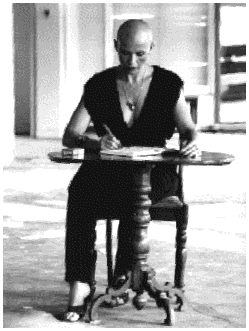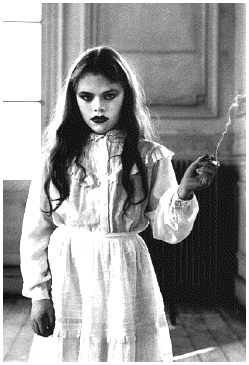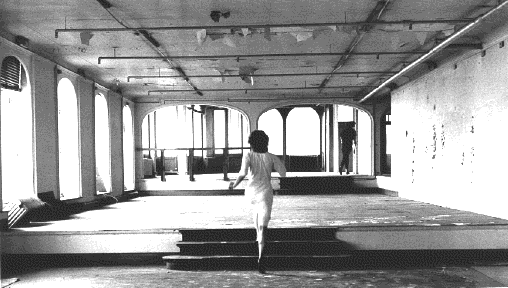Inspection
Jacques Derrida
Translated by
David Wills
Photographs by
Marie-Françoise Plissart
(The Monacelli Press)

Then:
Two religions or two cultures of the "detail," well, in fact two or one and the same, and they are also techniques or systems of knowledge, as well as fine arts, magnificent arts, arts of magnification. One becomes adept at enlarging or magnifying the minute and discrete element. Thus, whether deliberately or not, it necessarily becomes possible to idealize it, to dematerialize or spiritualize it, to charge it with significance. This is why you were right before to speak of mourning apropos this art of "magnification," as in the English term "magnifying glass" or "magnifier." You can also hear the word "fire," whether as a sign of death or of an optical device used by a pyromaniac.
There are eighty or so black-and-white photographs by Marie-Françoise Plissart, starting out with two women in bed with each other, and ending up with two women in bed with each other. In between, we get photographs of women running up and down huge bare stairs and in and out of huge bare rooms, and across huge bare streets, men throwing glasses on the floor, girls made up to look like women, women looking out of windows, games of checkers, a woman with no hair writing a note to herself (in Spanish), pieces of torn-up photographs on the ground, and enough people smoking to give the Surgeon-General heart failure.
It all takes place against a Last Year at Marienbad world --- empty rooms, empty streets, empty stairs, empty (and decayed) old buildings, and somewhat empty (or maybe, better, expressionless) people. These photographs have some magic --- not logical, but magic --- connection with each other, eight characters in search of each other, or an author, or nothing. At some point, photographs we've seen in early pages appear in pieces, or framed on the walls of the empty rooms later on (one of them gets smashed, too.)
In the last thirty pages, Jacques Derrida carries on a dialogue, presumably with himself, on the photographs. To say it's obscurantist is being generous, and at first, I couldn't make head-nor-tail of much of what was being said:
- Of course, but you can in no way avoid the fact that under the gaze --- and here the jurisdiction in force is that of the gaze --- all the parts of the image are by right, and in structure, assembled within the same instantaneous shot, within the time of an exposition or exposure that has no duration, even though dealing with it in "detail" requires that...One might even be tempted to say that this photographic work analyzes the way in which time is annulled --- the circle or (re)turn of the ring --- from the "first" to the "last" image, or the next-to-last, which is also the preview image. It is perhaps an "ahistory" that is being recounted here, a different temporality, the so-called timelessness of the unconscious, the ring of the eternal return, the hymen and the affirmation of women. And all this, which seems unthinkable, makes for a work that takes place --- that has a right to the place that the work occupies and at the same time analyzes ---a topo-photographic event.
Ho!
After having said all that, one can't doubt the fact that something strange and possibly wonderful is going on here. Just to open the book to any random page is to get sucked in to the starkness of the photographs, the sequence --- not unlike the sequence of early movies, pre-Technicolor, the powerful black-and-white of it, sometimes frozen in astonishing images, sometimes moving forward, simply, starkly, akin to the great American photographers of the Depression, and, in like manner, Plissart making us see a depression of people who, Derrida points out, are gazing past each other, not at each other.
 The words of Derrida may be a dialogue with himself, or with the reader, or with the photographs. Whatever it is, what is at first unintelligible begins to whirl us up in its strange logic, and leave us, like the photographs, a bit more stark and puzzling, and puzzled --- but not untouched:
The words of Derrida may be a dialogue with himself, or with the reader, or with the photographs. Whatever it is, what is at first unintelligible begins to whirl us up in its strange logic, and leave us, like the photographs, a bit more stark and puzzling, and puzzled --- but not untouched:
- The time of a cigarette is always measured in black and white. The thin layer of white paper gradually gives way to the gray-black of the ash...The cigarette thus passes silently from hand to hand like a relay baton, each time before the "decision" or disjunction that precipitates the development of a new generic series. I'd like to insist on this concurrence.
Derrida is a master of detail (he points out that "the invention of photography and the advent of psychoanalysis concur") and what we have here, for the first time --- at least, the first time for this reviewer --- the chance to see his meticulous detail-work addressed to highly iconographic photographs. Derrida spots the setting up of a game of checkers, and then reflects on this being reflected in (for example) the decorations of an entry-way, torn-up pieces of photos, and the emblematic moves of eight individuals.
He gives names to the individuals, gives them a symbolic identity, with names drawn from art, literature, religion, and contemporary culture: Pilar, Camille, Marie, Virginie, Claude.
In a sequence of photographs (happily reproduced in miniature on each page of Derrida's disquisition) we go from the checkers game to follow Pilar out of the building ("she gradually shrinks"), passing letters on the wall ("one can vaguely distinguish the letters SE, the beginning of so many possible words.") Then,
Her wanderings lead her up some stairs where she makes for another photograph on the wall, against a background that forms a tapestry of checkered squares (Photo #66). Once more within this photographic space --- but on the edges of the principal scene, this time on the left and not on the right --- there stands a woman. An observer, surveying the scene from the inside and the outside.
These photographs become a Rorschach test for us. In the puzzling clarity of them, we can create our own dimensions of terror, fear, love, wonder, tenderness and --- most of all --- a sense of existential isolation. By having Derrida guiding us in his master-detail work of observation, his microscopic study, drawing on his rich knowledge of western culture and camp --- he becomes the avid teacher, we become the avid students. Thus we are allowed to reach an understanding not only of what he sees in a sequence of provocative photographs, but, even better, to watch how his mind registers and reacts to material.
It's not unlike the one or two masterful teachers we had in school. They may have pretended to be instructing us in mathematics, or literature, or history, but in truth, they taught us how to envision the world through their eyes. They gave us a chance to watch their grappling with facts and by mixing facts and vision, to form genuine insight. By observing that process, we were able to learn "process" --- our own process of redemption --- because all learning, according to Blaise Cendars, is redemption.
Don't miss this one. The translation is great. Wills puts in parenthesis the French words that might be tricky; and with Derrida, you have to be a bit of a trickster. You can order Right of Inspection from
10 East 92nd St.
New York City 10128
